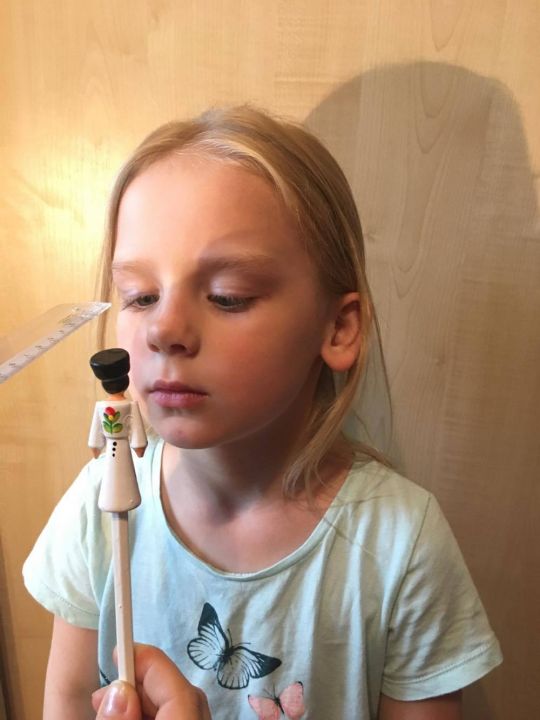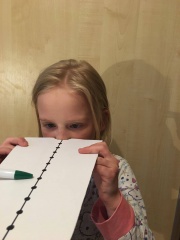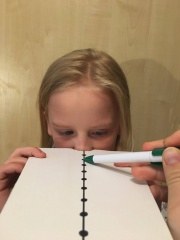Convergence Ability
All content on Eyewiki is protected by copyright law and the Terms of Service. This content may not be reproduced, copied, or put into any artificial intelligence program, including large language and generative AI models, without permission from the Academy.
Diagnostic Intervention
Description/Overview
Convergence ability can be tested with 2 different methods:
- Near point of convergence (NPC) - measurement of the point where the visual axes intersect under the maximum effort of the convergence.
- Jump convergence - assessment of the convergence quality of fixation when moving quickly from distance to a near target.
The convergence ability should be a part of routine examinations. Patients with a poor convergence while reading may suffer from headache, diplopia and/or blurred vision. Patients with poor convergence can also be asymptomatic.
Near point of convergence (NPC)
This is a standard test for convergence ability. It is easy to perform and does not require special equipment.
Equipment: A fixation target and a ruler.
The fixation target is a pen or pencil. To get the child's attention, a small toy with a common character and small details can be used. Alternatively, there is a special ruler for convergence and accommodation testing. If the patient has refractive error, the test should be performed with the needed correction.
Performing testing
- The patient should sit down in a comfortable chair and look directly at the fixation object that is held at a distance of approximately 50 cm in the mid-sagittal plane of the patient's head.
- The room should be well illuminated so the examiner can notice changes in eye movements.
- The examiner will move the fixation object slowly and smoothly in the mid-sagittal plane closer to the patient's nose. Moving speed should be approximately 40 cm in 10 seconds.
- While performing the test, the examiner should observe both of the patient's eyes as some patients do not notice diplopia when one of the eyes is not fixating.
- Ask the patient to let you know when he/she sees the fixation object turn double.
- When the near point of the convergence (NPC) is reached, move the fixation object away from both eyes of the patient in the mid-sagittal plane until he/she starts to fixate on the object with both eyes. Of note, there is a recovery point when a person is moving from the diplopia point to the point where convergence returns.
The test should be performed more than once to be sure that the patient understood and can follow the testing instructions. For the patients with convergence insufficiency, repeated sequential testing may move the near point of convergence point farther from the previous ones.
Results
The results of the test should be noted with NPC and convergence recovery point (CRP), for example, NPC 7cm, CRP 12 cm. The normal NPC is about 6-10 centimeters and the normal CRP is approximately 15 centimeters. If the NPC is more than 10 centimeters, this is a sign of poor convergence.
Jump convergence
This test is more consistent with the typical near viewing situation.
Equipment: The Dot Card or Brock String. The length of the card can be vary but must not be shorter than 20 centimeters. There are black dots at the midline of the card that are placed 1-2 centimeters from each other. If the patient is highly myopic or hyperopic, the test should be performed with the needed correction.
Performing testing
- The patient should sit down in a comfortable chair and the card placed at the level of the patient's nose.
- The room should be well illuminated, so any changes in eye movements can be noticed easily.
- Ask the patient to fixate on the farthest point on the card and ask:
How many lines are there?Are these lines crossing at the fixation point?
- If the patient can fixate on this point then move to the closer point and repeat the questions until the patient sees two parallel lines or just one line (in this case the other eye is suppressed)
- The closest point where the patient can see these two lines crossing at the fixation point is the near point of convergence (NPC).
The test should be performed more than once to be sure that the patient understood and can follow the testing instructions. For a patient who has convergence insufficiency, repeated tests may move the near point of convergence farther from the previous ones.
Results
Test results should be recorded as: convergence 8 centimeters (Brock String)
In an individual with a good convergence ability, both tests should show similar results.
Most common errors
- Relying on subjective near point of convergence (NPC) measures and not on objective observation of eye fixation.
- Performing the test only once.
- Moving the fixation target too fast, which can over estimate the convergence ability or moving the target too slow, where the child can lose interest in performing the test.
- Non-compliant patient or the examiner is not encouraging the patient to follow the fixation target. Using different objects each time can help keep a young child's interest.
- Not testing the patient in the standard gaze (slight downward) for convergence studies.
References
- David B. Elliott PhD, Clinical procedures in Primary eye care Fourth edition. Elsevier limited, 2014
- Brad Bowling Kanski's Clinical ophthalmology Eight edition. Elsevier limited, 2016
- Frank Eperjesi PhD, Hannah Bartlett PhD, Mark Dunne PhD Ophthalmic Clinical Procedures Elsevier limited, 2007
- Darcy A.Umphred PhD, Gordon U.Burton PhD, Rolando T. Lazaro PhD, Margaret L. Roller Umphred's neurological rehabilitation Six edition. Mosby, 2013.




